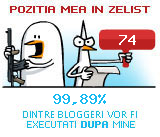That's what The Economist has to say about the most recent plans of Romanian public policies. Not bad, but with a cautionary tale:
Romania gets ready
Jul 31st 2007
From the Economist Intelligence Unit ViewsWire
Preparing for EU membership threatens fiscal health
Romania’s budget recorded a small deficit in the first half of the year, but is likely to run close to the EU-mandated 3% of GDP limit for the year as a whole as Prime Minister Calin Popescu Tariceanu’s government embarks on a massive infrastructure and welfare programme, designed to bring those areas of Romanian life into line with the rest of the EU.
Romania’s consolidated budget deficit was equal to 0.19% of GDP in the first half of the year, compared with a surplus of 0.16% of GDP in the year-earlier period, the finance ministry reported on July 27th. In local currency terms, the deficit was Lei750m (US$324m). This marks something of an improvement in the second quarter, since the January-March gap was Lei450m. Revenue was equal to 15% of GDP (Lei58.6bn), while expenditure reached 15.2% of GDP (Lei59.3bn).
A strong position
For an economy that ran a fiscal deficit of 1.6% of GDP last year, the first-half fiscal outturn is impressive. Of course it is helped by economic growth, which although slowing from 2006’s 7.7% expansion in GDP was still growing at 6% in the first quarter. This is being powered by buoyant private consumption, on the back of expanded employment and fast-rising wages. As a result, there is little need for pump-priming. Yet this is precisely what Mr Tariceanu’s government proposes.
Its 2007 budget law sees revenue of 39% of GDP and spending at 41.7%—the highest level since the end of communism. As a result, the government expects the deficit to balloon to 2.8% of GDP this year, with barely any change planned for 2008. The European Commission is less convinced that the government will keep the deficit within the EU’s guideline 3% of GDP ceiling: it projects an increase in the consolidated budget deficit, from 1.9% of GDP in 2006 to 3.2% of GDP in 2007 and the same in 2008, using the ESA 95 methodology. Mainly because we believe the revenue target for 2007 is unduly optimistic, the Economist Intelligence Unit forecasts a fiscal deficit of 3.1% of GDP this year.
The projected increase in the deficit (based on the budget proposal) is largely driven by increases in government capital expenditure projects equivalent to 3.6% of GDP, and increases in social security benefits equivalent to 0.4% of GDP. These will be partially offset by increases in income tax and VAT equivalent to 1.5% of GDP, and cuts in subsidies equivalent to 0.9% of GDP.
Mr Tariceanu says the massive increases in spending are necessary to modernise Romania’s infrastructure and bring its welfare system closer to EU standards. In June, his government decided to double state pensions over a two-year period, at a predicted cost in 2008 of €2bn (US$2.7bn).
Look before you leap
Mr Tariceanu’s plans for a “great leap” to catch up with Western Europe in the fields of infrastructure and welfare carry several dangers for the country.
First, they threaten to exacerbate the current-account deficit, which ran at an elevated 11.6% of GDP in the first quarter on the back of the Romanian consumer’s thirst for imports and a dramatic expansion in credit. Worryingly, as the deficit has expanded the country’s ability to finance it through foreign direct investment (FDI) has contracted. In the first four months of the year, FDI covered just 36% of the current-account deficit, compared with 87% coverage in the year-earlier period.
Second, Romania is moving away from adherence to the Maastricht criteria for membership of the euro area. Several new member states are struggling with fiscal problems inherited from previous governments; the emerging problem in Romania is purely of this government’s making.
Third, and perhaps most seriously, there is a serious risk of provoking a resurgence of inflation. Romania’s progress in this front was hard-won, as it was one of the last accession states to achieve single-digit inflation. Last year, consumer-price inflation averaged 6% and it stood at 3.8% year on year for a third consecutive month in June. However, very strong domestic demand and the procyclical fiscal policy that is helping to suck in imports could fire inflation once again. In addition, sharp increases in the minimum wage and three rounds of wage increases in the public sector could reignite inflationary expectations and spill over into the private sector.
We forecast real GDP growth of 6.5% in 2007 and 5.5% in 2008. However, the economy's continued rapid growth will lead to a worsening macroeconomic imbalance. The current account deficit will expand to 11.4% of GDP in 2007 and 13.1% in 2008; it will not fall below 12% of GDP until 2010. The fiscal deficit, meanwhile, will rise to 3% of GDP in 2008 and will only very gradually ease down in the years that follow. So far, the outlook for consumer-price inflation is relatively healthy: we see an average rate of 4% this year, 4.3% in 2008 and 4.1% in 2009. This raises a serious question mark over Romania’s ability to adopt the euro, but at least it doesn’t threaten runaway inflation that would seriously erode macroeconomic achievements. Nevertheless, the risks of wage rises reigniting inflationary expectations cannot be discounted. Mr Tariceanu would do well to remember that great leaps tend to end with hard landings.
miercuri, 1 august 2007
Good tidings, shrouded in danger
Scris de Turambar at 10:15
Etichete: English, Politics, Romania, The Economist
Abonați-vă la:
Postare comentarii (Atom)





0 comentarii:
Trimiteți un comentariu